(完整版)潮汕出花园英文版
- 格式:doc
- 大小:25.01 KB
- 文档页数:2

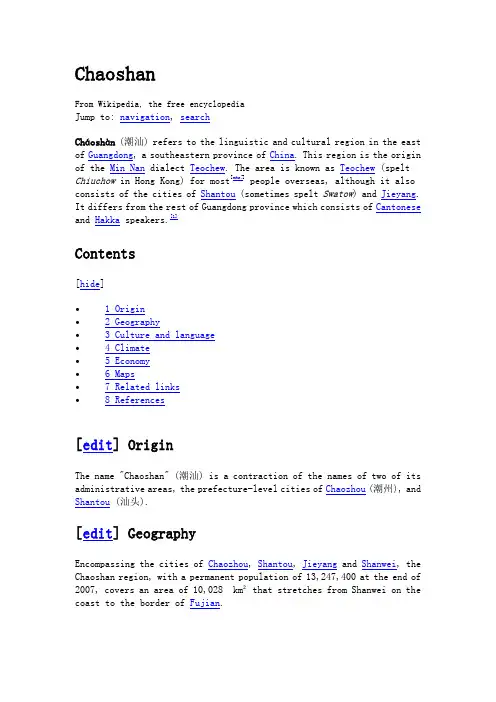
ChaoshanFrom Wikipedia, the free encyclopediaJump to: navigation, searchCháoshàn(潮汕) refers to the linguistic and cultural region in the east of Guangdong, a southeastern province of China. This region is the origin of the Min Nan dialect Teochew. The area is known as Teochew (spelt Chiuchow in Hong Kong) for most[who?] people overseas, although it also consists of the cities of Shantou (sometimes spelt Swatow) and Jieyang. It differs from the rest of Guangdong province which consists of Cantonese and Hakka speakers.[1]Contents[hide]• 1 Origin• 2 Geography• 3 Culture and language• 4 Climate• 5 Economy• 6 Maps•7 Related links•8 References[edit] OriginThe name "Chaoshan" (潮汕) is a contraction of the names of two of its administrative areas, the prefecture-level cities of Chaozhou(潮州), and Shantou (汕头).[edit] GeographyEncompassing the cities of Chaozhou, Shantou, Jieyang and Shanwei, the Chaoshan region, with a permanent population of 13,247,400 at the end of 2007, covers an area of 10,028 km² that stretches from Shanwei on the coast to the border of Fujian.[edit] Culture and languageThis is a unique area with its own culture that is quite different from its neighbours in Guangdong and the rest of China. It does, however, share similarities to the Minnan areas just north of Chaoshan in Fujian Province. One of the main reasons for its uniqueness is its language, called Chaozhou (also spelt Teochew). It is said that this dialect of Chinese is one of the most difficult ones to master, as it has 8 tones compared to the 4 tones found in Mandarin. Music, opera, and food are further characteristics that distinguish Chaoshan people from the rest of Guangdong.Chaozhou Dialect (潮州話), by which the Chaozhou culture conveys, is considered as one of the oldest Chinese dialects for it preserves many elegant and refined features from ancient Chinese that have been lost in some of the other modern dialects of Chinese. It is spoken by about 10 million people in local Chaozhou and approximately 2-5 million overseas.Chaozhou OperaChaozhou opera (潮劇) is a traditional art form which has a history of more than 500 years and is now loved by 20 million Chaozhou natives in over 20 countries and regions. Based on the local folk dances and ballads, Chaozhou opera has formed its own style under the influence of Nanxi opera. Nanxi is one of the oldest Chinese operas that originated in the Song Dynasty. Its tunes are graceful and pleasant, full of local color. The old form of choral accompaniment still remains its special features. Clowns and females are the most distinctive characters in a Chaozhou opera,and fan-playing and acrobatic skills are more prominent than in other types of performances.Gongfu tea(工夫茶), the 'espresso' of Chinese teas with a formidable kick, which was first sipped back in the Song Dynasty, is still flourishing and remains an important part of social etiquette in Chaozhou. If you visit a family, you can be sure of at least one round of Ganghu tea. Though it tastes bitter when it first reaches your mouth, it is the lingering aftertaste that makes Ganghu tea probably the most charming tea culture in China. Drinking Ganghu tea is in fact a process of aesthetics rather than a solution to thirst.At the local teahouse, tea service is often accompanied with Chaozhou music (潮州音樂). String music, the gong and drum music, the ancient music of set flutes are the traditional play forms of Chaozhou music. Chaozhou string music is made up of mostly plucked and bowed string instruments, and on some occasions, wind instruments are used. The most characteristic instruments are the rihin(二弦), tihu(提胡) and yahu(all two-stringed bowed lutes), the sanxian, pipa, ruan, guzheng, and yangqin. The number of instruments and performers in the ensemble is flexible and depends on the availability of instruments and musicians to play them - but to have an even and balanced texture only one of each instrument is preferred. Chaozhou drum music includes the big drum and gong, the small drum and gong, the dizi set drum and dong and su drum and gong ensembles. The current Chaozhou drum music is said to be similar to the form of the Drum and Wind Music of the Han and Tang Dynasties. Chaozhou guzheng(潮州古筝) is also regarded a major genre of Southern style of Chinese guzheng.[edit] ClimateA temperate climate and fresh seafood attracts many visitors to this area. The people are more relaxed than other areas of China, smoking rate is less, and work should always take the backseat to noon naps and Gong Fu tea[citation needed]. Many visitors from Hong Kong flock to the area for the great food known throughout China. The food is subtle and so is able to retain its original flavor without being tampered by soy sauce, vinegar, chili, and other sauces. Other favorites are beef balls, fish balls, rice noodle, and numerous other small treats.[edit] EconomyIn recent years, due to corruption and car smuggling in the 1980s and 1990s, the central government has chosen to slow down growth of this region eventhough it is still designated as an SEZ (Special Economic Zone). This has had a major effect on the lives of Chaoshan people. Business is not as vibrant compared to other areas in Guangdong and Shantou University is finding it hard to attract local high school graduates. Despite of that, new construction is prevalent and there appears to be hope in the horizon for this unique area on the coast of Southeast China. The other factor that benefits this area is the overwhelming Overseas Chinese from this area. The richest Chinese person in the world Li Ka Shing is from this region. He has invested greatly on the education and healthcare of this region.[edit] Maps•Chaozhou Prefecture (in yellow), part of the Chaoshan Teochiulinguistic region•Shantou Prefecture (in yellow), part of the Chaoshan Teochiulinguistic region•Jieyang Prefecture (in yellow), part of the Chaoshan Teochiulinguistic region•Shanwei Prefecture (in yellow), part of the Chaoshan Teochiu linguisticSnack鸭母念鼠壳稞绿豆饼果条卷糕果牛肉果条酥饺肠粉翻沙芋蚝烙潮州牛肉丸猪脚圈浮蕃薯尖米丸汤果汁炒糕果肠粉十一、薄壳早餐的配菜糯米胀猪肠血蛤三十一、、腐乳饼功夫茶。
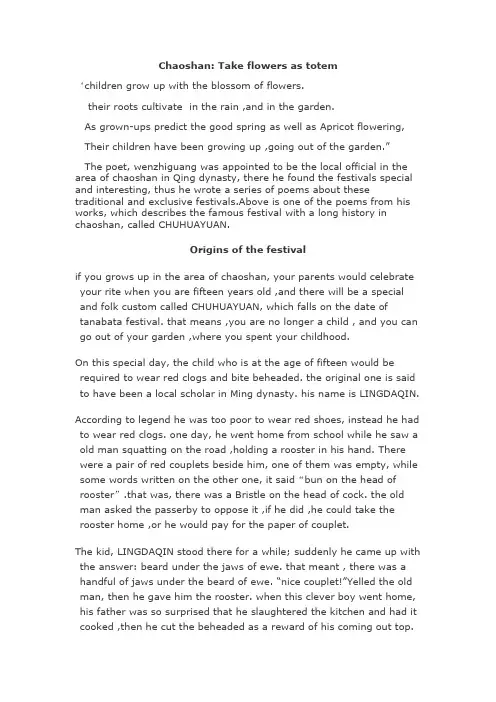
Chaoshan: Take flowers as totem‘children grow up with the blossom of flowers.their roots cultivate in the rain ,and in the garden.As grown-ups predict the good spring as well as Apricot flowering, Their children have been growing up ,going out of the garden.”The poet, wenzhiguang was appointed to be the local official in the area of chaoshan in Qing dynasty, there he found the festivals special and interesting, thus he wrote a series of poems about these traditional and exclusive festivals.Above is one of the poems from his works, which describes the famous festival with a long history in chaoshan, called CHUHUAYUAN.Origins of the festivalif you grows up in the area of chaoshan, your parents would celebrate your rite when you are fifteen years old ,and there will be a special and folk custom called CHUHUAYUAN, which falls on the date of tanabata festival. that means ,you are no longer a child , and you can go out of your garden ,where you spent your childhood.On this special day, the child who is at the age of fifteen would be required to wear red clogs and bite beheaded. the original one is said to have been a local scholar in Ming dynasty. his name is LINGDAQIN. According to legend he was too poor to wear red shoes, instead he had to wear red clogs. one day, he went home from school while he saw a old man squatting on the road ,holding a rooster in his hand. There were a pair of red couplets beside him, one of them was empty, while some words written on the other one, it said“bun on the head of rooster”.that was, there was a Bristle on the head of cock. the old man asked the passerby to oppose it ,if he did ,he could take the rooster home ,or he would pay for the paper of couplet.The kid, LINGDAQIN stood there for a while; suddenly he came up with the answer: beard under the jaws of ewe. that meant , there was a handful of jaws under the beard of ewe. “nice couplet!”Yelled the old man, then he gave him the rooster. when this clever boy went home, his father was so surprised that he slaughtered the kitchen and had it cooked ,then he cut the beheaded as a reward of his coming out top.Later, he really became a famous scholar. The people in chaoshan thought it was a good omen, thus they let their children wear red clogs and bite beheaded before the children entered the school.this particular behavior gradually changed to be a custom, that is CHUHUAYUAN.Ceremony of the festivalNowadays simple ceremony have been held instead of the complicated one in ancient days on the date of CHUHUAYUAN festival. In 19th century parents who have 15-year-old kids would be busy for a couple of days or ever longer. Firstly, though the custom normally falls on the double seventh night, the parents would prefer to divining for a suitable day which was good for their kids . Then they would collect twelve different kinds of flowers , which were used for their kids taking shower. it was said it would bring the kids good luck. Besides, the children were requested to sacrifice one kind of immortal called POMU on the bed and they were not allowed to see people. In addition to that, there were so many complex and long ceremonies taken for this important day.Later, the people in chaoshao abandoned several procedures of this festival just for simple cerebration. They would take the kids to restaurant and bring them gifts , hoping that their lovely kids will be reliable for their lives bravely .However, some traditional and folk ways to cerebrate this special custom are still remained in some areas of chaoshan today. for example, the children would be required to bite beheaded just like their fathers did before.With the blossom of flowers, children have grown up. Once they were cultivated in the garden, and in their parents’ arms. Now it’s time for them to go out of the garden, to be grow-ups, with theirparents’ hope.。
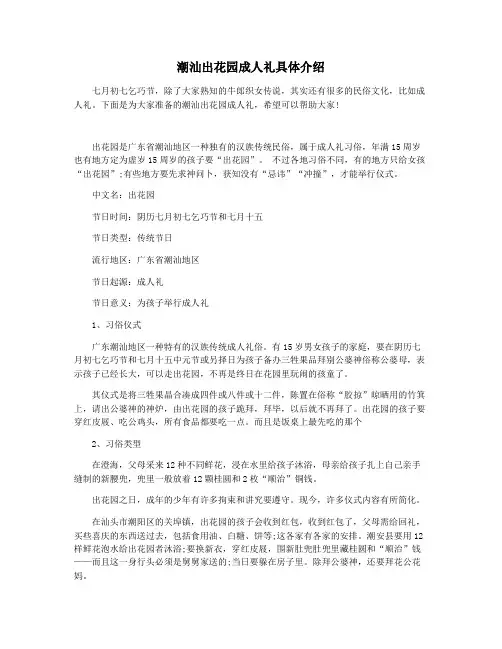
潮汕出花园成人礼具体介绍七月初七乞巧节,除了大家熟知的牛郎织女传说,其实还有很多的民俗文化,比如成人礼。
下面是为大家准备的潮汕出花园成人礼,希望可以帮助大家!出花园是广东省潮汕地区一种独有的汉族传统民俗,属于成人礼习俗,年满15周岁也有地方定为虚岁15周岁的孩子要“出花园”。
不过各地习俗不同,有的地方只给女孩“出花园”;有些地方要先求神问卜,获知没有“忌讳”“冲撞”,才能举行仪式。
中文名:出花园节日时间:阴历七月初七乞巧节和七月十五节日类型:传统节日流行地区:广东省潮汕地区节日起源:成人礼节日意义:为孩子举行成人礼1、习俗仪式广东潮汕地区一种特有的汉族传统成人礼俗。
有15岁男女孩子的家庭,要在阴历七月初七乞巧节和七月十五中元节或另择日为孩子备办三牲果品拜别公婆神俗称公婆母,表示孩子已经长大,可以走出花园,不再是终日在花园里玩闹的孩童了。
其仪式是将三牲果晶合凑成四件或八件或十二件,陈置在俗称“胶掠”晾晒用的竹箕上,请出公婆神的神炉,由出花园的孩子跪拜,拜毕,以后就不再拜了。
出花园的孩子要穿红皮屐、吃公鸡头,所有食品都要吃一点。
而且是饭桌上最先吃的那个2、习俗类型在澄海,父母采来12种不同鲜花,浸在水里给孩子沐浴,母亲给孩子扎上自己亲手缝制的新腰兜,兜里一般放着12颗桂圆和2枚“顺治”铜钱。
出花园之日,成年的少年有许多拘束和讲究要遵守。
现今,许多仪式内容有所简化。
在汕头市潮阳区的关埠镇,出花园的孩子会收到红包,收到红包了,父母需给回礼,买些喜庆的东西送过去,包括食用油、白糖、饼等;这各家有各家的安排。
潮安县要用12样鲜花泡水给出花园者沐浴;要换新衣,穿红皮屐,围新肚兜肚兜里藏桂圆和“顺治”钱——而且这一身行头必须是舅舅家送的;当日要躲在房子里。
除拜公婆神,还要拜花公花妈。
男出花园者,祭品中要有一只公鸡,女者用母鸡,要请亲族吃酒菜。
澄海县风俗与潮安县大体相同。
饶平县用榕树枝、竹枝、石榴花、桃树枝、状元竹、青草各一对合12样泡水给出花园者沐同时进食,祝贺出花园者“换上成人肠肚”,与童年告别。
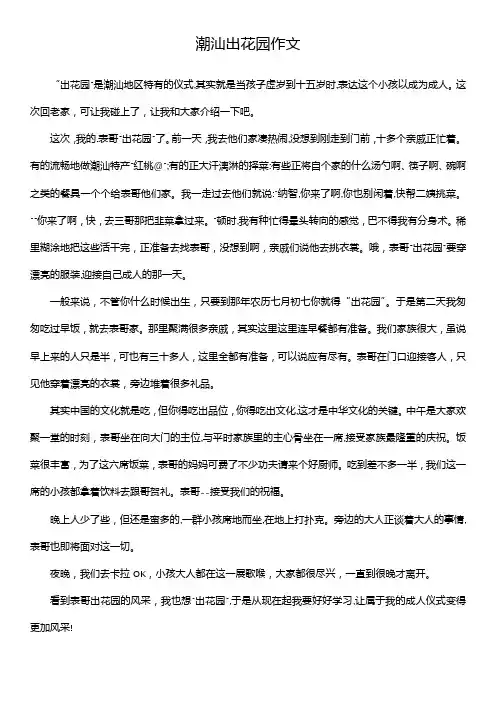
潮汕出花园作文“出花园”是潮汕地区特有的仪式,其实就是当孩子虚岁到十五岁时,表达这个小孩以成为成人。
这次回老家,可让我碰上了,让我和大家介绍一下吧。
这次,我的.表哥“出花园”了。
前一天,我去他们家凑热闹,没想到刚走到门前,十多个亲戚正忙着。
有的流畅地做潮汕特产“红桃@”;有的正大汗漓淋的择菜:有些正将自个家的什么汤勺啊、筷子啊、碗啊之类的餐具一个个给表哥他们家。
我一走过去他们就说:"纳智,你来了啊,你也别闲着,快帮二姨挑菜。
"“你来了啊,快,去三哥那把韭菜拿过来。
”顿时,我有种忙得晕头转向的感觉,巴不得我有分身术。
稀里糊涂地把这些活干完,正准备去找表哥,没想到啊,亲戚们说他去挑衣裳。
哦,表哥“出花园”要穿漂亮的服装,迎接自己成人的那一天。
一般来说,不管你什么时候出生,只要到那年农历七月初七你就得“出花园”。
于是第二天我匆匆吃过早饭,就去表哥家。
那里聚满很多亲戚,其实这里这里连早餐都有准备。
我们家族很大,虽说早上来的人只是半,可也有三十多人,这里全都有准备,可以说应有尽有。
表哥在门口迎接客人,只见他穿着漂亮的衣裳,旁边堆着很多礼品。
其实中国的文化就是吃,但你得吃出品位,你得吃出文化,这才是中华文化的关键。
中午是大家欢聚一堂的时刻,表哥坐在向大门的主位,与平时家族里的主心骨坐在一席,接受家族最隆重的庆祝。
饭菜很丰富,为了这六席饭菜,表哥的妈妈可费了不少功夫请来个好厨师。
吃到差不多一半,我们这一席的小孩都拿着饮料去跟哥贺礼。
表哥--接受我们的祝福。
晚上人少了些,但还是蛮多的,一群小孩席地而坐,在地上打扑克。
旁边的大人正谈着大人的事情,表哥也即将面对这一切。
夜晚,我们去卡拉OK,小孩大人都在这一展歌喉,大家都很尽兴,一直到很晚才离开。
看到表哥出花园的风采,我也想"出花园”,于是从现在起我要好好学习,让属于我的成人仪式变得更加风采!。
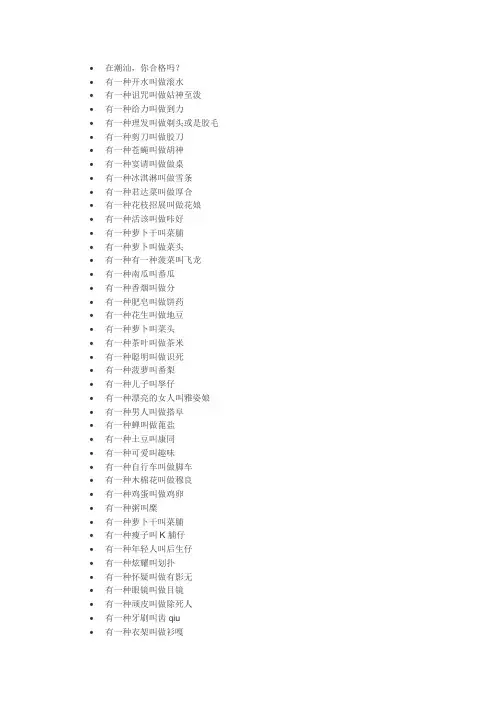
•在潮汕,你合格吗?•有一种开水叫做滚水•有一种诅咒叫做姑神至泼•有一种给力叫做到力•有一种理发叫做剃头或是胶毛•有一种剪刀叫做胶刀•有一种苍蝇叫做胡神•有一种宴请叫做做桌•有一种冰淇淋叫做雪条•有一种君达菜叫做厚合•有一种花枝招展叫做花娘•有一种活该叫做咔好•有一种萝卜干叫菜脯•有一种萝卜叫做菜头•有一种有一种菠菜叫飞龙•有一种南瓜叫番瓜•有一种香烟叫做分•有一种肥皂叫做饼药•有一种花生叫做地豆•有一种萝卜叫菜头•有一种茶叶叫做茶米•有一种聪明叫做识死•有一种菠萝叫番梨•有一种儿子叫孥仔•有一种漂亮的女人叫雅姿娘•有一种男人叫做搭阜•有一种蝉叫做蓖盐•有一种土豆叫康同•有一种可爱叫趣味•有一种自行车叫做脚车•有一种木棉花叫做穆良•有一种鸡蛋叫做鸡卵•有一种粥叫糜•有一种萝卜干叫菜脯•有一种瘦子叫K脯仔•有一种年轻人叫后生仔•有一种炫耀叫划扑•有一种怀疑叫做有影无•有一种眼镜叫做目镜•有一种顽皮叫做除死人•有一种牙刷叫齿qiu•有一种衣架叫做衫嘎•有一种芒果叫做shuan (我也打不出字)•有一种河粉叫做果仔•有一种碗叫做凹•有一种蚊子叫做挽•有一种公猪叫做猪哥•有一种旅游叫做剔桃•有一种生气叫做逼过火•有一种装b叫做张鬼•有一种游泳叫做siu•有一种铲子叫做鼎le•有一种篮子叫做轻•有一种色狼叫做妻哥•有一种砍柴刀叫做厚刀•有一种菜刀叫做班刀•有一种有一种不小心叫做唔知关•有一种石榴叫做绑仔•有一种空心菜叫做应菜•有一种荔枝叫做耐guai•有一种龙眼叫做肉暧•有一种泥鳅叫做土妞•有一种芦苇叫做忙•有一种锅叫做鼎•有一种衣叉叫做tuo叉•有一种化粪池叫做大学•有一种孑孓叫做痴•有一种凉粉叫做草果•有一种吵闹叫做节死人•有一种妒忌叫做格目•有一种嚣张叫做骁老•有一种木瓜叫做玲瓜•有一种鸡舍叫做鸡寮•有一种汽车叫做大车•有一种劳心劳肺叫做驳季•有一种鱼饭叫做熟鱼•有一种祝贺新家建成叫做入处•有一种床叫做明天床•有一种师傅叫做狮父•有一种舞狮叫做茂狮•有一种慷慨叫做po老•有一种吝啬叫做老咸•有一种捣乱叫做ba莽•有一种酱油叫做是油•有一种奇怪叫做怪浪•有一种楼板叫做刘邦•有一种过梁叫做楼yie•有一种钳刀叫做业仔•有一种胡说八道叫做漏风•有一种吹牛就做抽风•有一种娶老婆叫做trouble•有一种女儿叫做走仔•有一种刚才叫做船早或是指船•有一种酒杯叫做酒精•有一种香蕉叫做根蕉•有一种包菜叫做哥lie•有一种黄瓜叫做吊瓜•有一种毛巾叫做面布•有一种讨厌叫做卤•有一种可怜叫做叔恶•有一种皮肤过敏叫做起楼•有一种甘蔗叫做竹蔗或乌腊•有一种红糖叫做乌糖•有一种流氓叫做派仔•有一种无奈叫做无变•有一种人字拖叫做业脚宰•有一种老婆叫做亩•有一种认干爹叫做客人契•有一种制作肠粉就做炊果子•有一种煮饭的工序叫做落水•有一种烧焦叫做着火烧•有一种失火叫做火烧处•有一种投毒叫做落药•有一种投机取巧叫做臭心事•有一种盛凉叫做la凉•有一种气球就做鸡归•有一种打气筒叫做风秦•有一种轮胎叫做尼•有一种贵柜子叫做du•有一种塞车叫做堵车•有一种厚颜无耻叫做面皮厚过街路石•有一种丢失叫做胶劳•有一种有一种叫鸡叫做剁鸡•有一种东西叫做物件•有一种洗衣粉叫做洗衫粉•有一种打架叫做烧拍•有一种帮助叫做烧护•有一种有一种麻烦你叫做劳你•有一种偏差叫做走zua•有一种蟑螂叫做胶zua•有一种放松叫做散尸•有一种不经意叫做唔知关•有一种不小心叫做唔知关•有一种不可能叫做无影只•有一种唢呐叫做低禾•有一种死亡也叫做低禾或者是希胡•有一种神经叫做小个•有一种傻子叫做白人•有一种大鞭炮叫做大称•有一种跳东西用的棍子叫做平当或是竹颓•有一种喷药叫做竖药•有一种拔草叫做莽草•有一种玩扑克叫做bua牌•有一种下棋叫做行棋•有一种跳叫做丛(4声)•有一种随便叫做ruan•有一种发霉叫做生姑•有一种担心叫做还luo•有一种橡皮筋叫做树尼•有一种橡皮擦叫做qiu•有一种透明胶叫做胶纸•有一种文具盒叫做笔盒•有一种还长之呢叫做胶罗•有一种安静叫做掂掂•有一种故意叫做装爱•有一种马蹄叫做钱苍•有一种榕树叫做神•有一种装可怜叫做哭苦•有一种无花果叫做脸雾•有一种黄皮叫做黄带•有一种哪里叫做坟•有一种不认识叫做唔北•有一种明天叫做嘛早•有一种具体问题具体分析的方法叫做像号•有一种吹口哨叫做peng机究•有一种功夫或本领叫做康卦•有一种不会吧叫做我看勿•有一种口哨叫做机究•有一种夸张叫做还头死绝•有一种毒蛇叫做饭时称•有一种方便面叫做鸡面•有一种青草药叫做青药•有一种地板叫做土下•有一种划船叫做撑船•有一种戴帽子叫做帝帽•有一种穿衣服叫做称衫•有一种离开叫做坟块去•有一种臭小子叫做震肚子•有一种哪里叫做地块•有一种热叫做rua死•有一种寒冷叫做言死•有一种疙瘩叫做浮鸡母皮•有一种天气叫做天时•有一种出太阳叫做出日•有一种晕倒叫做乌暗形•有一种夜晚叫做一夜•有一种流浪就做当猪哥•有一种无人问津叫做老爷伯自爱•有一种爬竹竿叫做雪竹杠•有一种吹牛叫做拉康•有一种炸油条叫做浮油炸果•有一种生存叫做讨赚•有一种塑料袋叫做腊纸袋或者是田料袋•有一种刮风叫做透风•有一种赛太阳叫做瀑日•有一种成人礼叫做出花园•有一种蟋蟀叫做杜猴•有一种吸血虫叫做侯奇•有一种发春叫做起群•有一种蚯蚓叫做厚稳•有一种宠爱叫做升公•有一种锄头叫做筷头•有一种腐烂就做失掉•有一种建房子叫做起处•有一种操劳叫做拖磨•有一种上坡叫做激企•有一种停留叫做落脚•有一种什么价格叫做尿钱•有一种不一会儿叫做一困仔•有一种中午叫做日逗•有一种旁晚叫做夜昏埔•有一种早晨叫做明起早•有一种大人物叫做大粒•有一种买叫做喝•有一种姑神叫做伴挽,有一种伴挽就做至泼。
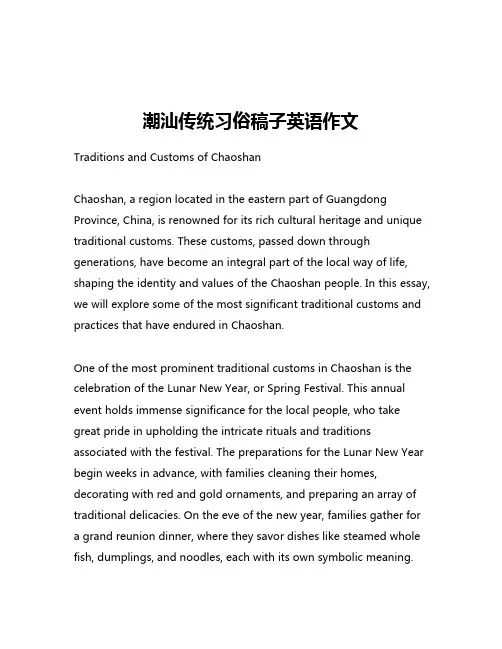
潮汕传统习俗稿子英语作文Traditions and Customs of ChaoshanChaoshan, a region located in the eastern part of Guangdong Province, China, is renowned for its rich cultural heritage and unique traditional customs. These customs, passed down through generations, have become an integral part of the local way of life, shaping the identity and values of the Chaoshan people. In this essay, we will explore some of the most significant traditional customs and practices that have endured in Chaoshan.One of the most prominent traditional customs in Chaoshan is the celebration of the Lunar New Year, or Spring Festival. This annual event holds immense significance for the local people, who take great pride in upholding the intricate rituals and traditions associated with the festival. The preparations for the Lunar New Year begin weeks in advance, with families cleaning their homes, decorating with red and gold ornaments, and preparing an array of traditional delicacies. On the eve of the new year, families gather for a grand reunion dinner, where they savor dishes like steamed whole fish, dumplings, and noodles, each with its own symbolic meaning.Another cherished tradition in Chaoshan is the annual Qingming Festival, also known as Tomb Sweeping Day. This solemn occasion is dedicated to honoring the ancestors and paying respects to the departed. Families visit the graves of their loved ones, cleaning the tombstones, burning incense, and offering traditional offerings such as food, flowers, and paper money. The ritual of tomb sweeping is not only a way to remember and honor the dead but also a means of maintaining strong familial bonds and a sense of ancestral heritage.The Chaoshan region is also renowned for its unique culinary traditions, which have been passed down through generations. The local cuisine, often referred to as Chaozhou cuisine, is characterized by its delicate flavors, intricate preparation techniques, and the use of fresh, high-quality ingredients. One of the most iconic Chaozhou dishes is the Teochew-style braised goose, which involves a meticulous process of marinating, steaming, and slow-cooking the bird to achieve a tender and flavorful result. Another beloved dish is the Teochew-style steamed rice rolls, made from a batter of rice flour and water, which are then filled with a variety of savory or sweet ingredients and steamed to perfection.In addition to culinary traditions, the Chaoshan region is also known for its rich textile heritage. The art of Chaozhou embroidery, known as Teochew embroidery, is a time-honored tradition that showcases the exceptional skills and artistry of local craftspeople. Teochewembroidery is characterized by its intricate designs, vibrant colors, and the use of delicate silk threads. These embroidered pieces are often used to adorn traditional clothing, accessories, and household items, serving as a testament to the region's artistic legacy.Another significant aspect of Chaoshan's cultural heritage is the traditional Teochew opera, a form of Chinese theater that has been practiced in the region for centuries. Teochew opera is renowned for its unique musical style, elaborate costumes, and captivating performances that often depict stories from Chinese history and mythology. The art form has been carefully preserved by local troupes and enthusiasts, who work tirelessly to ensure that this tradition continues to thrive and be passed on to future generations.The Chaoshan region is also home to a rich tradition of folk arts and crafts, including the creation of intricate paper-cutting designs, the making of traditional ceramic wares, and the carving of wooden figurines. These artisanal practices not only showcase the creativity and skill of the local artisans but also serve as a means of preserving the region's cultural identity and heritage.In conclusion, the traditional customs and practices of the Chaoshan region are a testament to the enduring resilience and cultural richness of the local people. From the celebrations of the Lunar New Year and Qingming Festival to the renowned culinary traditions,textile arts, and performing arts, these customs have become an integral part of the Chaoshan identity, connecting the present with the past and shaping the unique character of the region. As the world continues to evolve, it is crucial that these traditions are preserved and celebrated, ensuring that the rich cultural heritage of Chaoshan is passed down to future generations.。

潮汕出花园作文500字(中英文实用版)Title: The Garden of ChaozhouStepping into the garden of Chaozhou, one is immediately captivated by the enchanting fusion of nature and culture.The air, heavy with the scent of blooming flowers, carries whispers of history and tradition that have been cultivated over centuries.走进潮汕的花园,你立刻会被自然与文化的迷人融合所吸引。
空气中,弥漫着盛开的花朵的香气,承载着历经数百年培育的历史与传统。
Wandering through the meticulously manicured paths, one encounters an array of vibrant flowers, each representing a unique story and symbol.The peony, with its voluptuous petals, stands as a symbol of wealth and prosperity, while the delicate lotus represents purity and integrity.漫步在精心修剪的小径上,你会遇到一系列充满活力的花朵,每一朵都讲述着独特的故事和象征。
牡丹以其丰满的花瓣象征着财富和繁荣,而精致的莲花则代表着纯洁和诚实。
In the garden, ancient trees provide shade and solace, their gnarled branches reaching towards the sky as if in silent contemplation.Stone pavilions and bridges add an artistic touch, their intricate carvings showcasing the exquisite craftsmanship of the Chaozhou people.在花园里,古树提供阴凉和慰藉,它们扭曲的树枝伸向天空,仿佛在默默沉思。
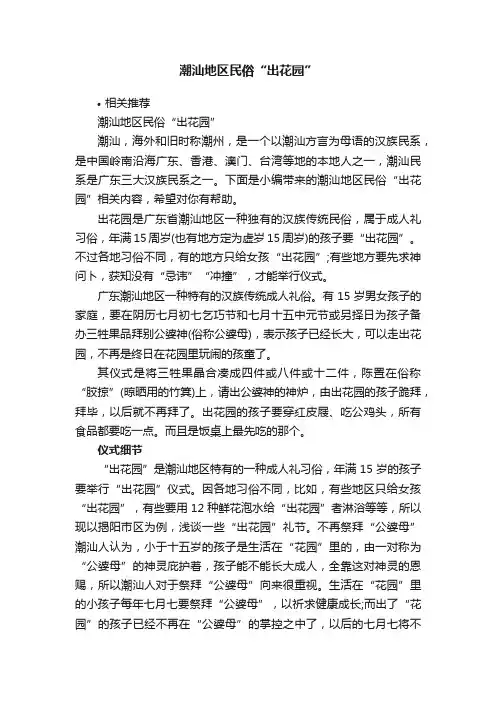
潮汕地区民俗“出花园”•相关推荐潮汕地区民俗“出花园”潮汕,海外和旧时称潮州,是一个以潮汕方言为母语的汉族民系,是中国岭南沿海广东、香港、澳门、台湾等地的本地人之一,潮汕民系是广东三大汉族民系之一。
下面是小编带来的潮汕地区民俗“出花园”相关内容,希望对你有帮助。
出花园是广东省潮汕地区一种独有的汉族传统民俗,属于成人礼习俗,年满15周岁(也有地方定为虚岁15周岁)的孩子要“出花园”。
不过各地习俗不同,有的地方只给女孩“出花园”;有些地方要先求神问卜,获知没有“忌讳”“冲撞”,才能举行仪式。
广东潮汕地区一种特有的汉族传统成人礼俗。
有15岁男女孩子的家庭,要在阴历七月初七乞巧节和七月十五中元节或另择日为孩子备办三牲果品拜别公婆神(俗称公婆母),表示孩子已经长大,可以走出花园,不再是终日在花园里玩闹的孩童了。
其仪式是将三牲果晶合凑成四件或八件或十二件,陈置在俗称“胶掠”(晾晒用的竹箕)上,请出公婆神的神炉,由出花园的孩子跪拜,拜毕,以后就不再拜了。
出花园的孩子要穿红皮屐、吃公鸡头,所有食品都要吃一点。
而且是饭桌上最先吃的那个。
仪式细节“出花园”是潮汕地区特有的一种成人礼习俗,年满15岁的孩子要举行“出花园”仪式。
因各地习俗不同,比如,有些地区只给女孩“出花园”,有些要用12种鲜花泡水给“出花园”者淋浴等等,所以现以揭阳市区为例,浅谈一些“出花园”礼节。
不再祭拜“公婆母”潮汕人认为,小于十五岁的孩子是生活在“花园”里的,由一对称为“公婆母”的神灵庇护着,孩子能不能长大成人,全靠这对神灵的恩赐,所以潮汕人对于祭拜“公婆母”向来很重视。
生活在“花园”里的小孩子每年七月七要祭拜“公婆母”,以祈求健康成长;而出了“花园”的孩子已经不再在“公婆母”的掌控之中了,以后的七月七将不再祭拜“公婆母”了。
身穿新衣,脚着木屐,头戴“石榴”花“出花园”这天,小孩子要穿舅舅送来的新衣,木屐,一般为红色。
当然,现今很多繁琐礼节已经被简化,舅舅可以直接送红包给外甥(女),让孩子自己置办。
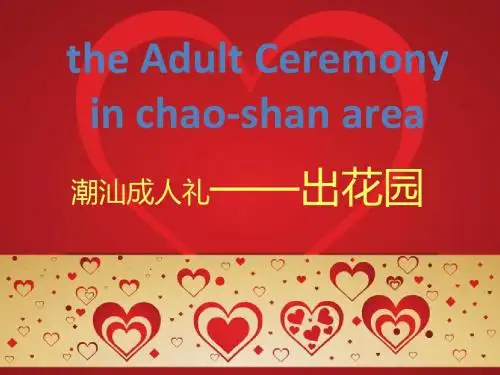
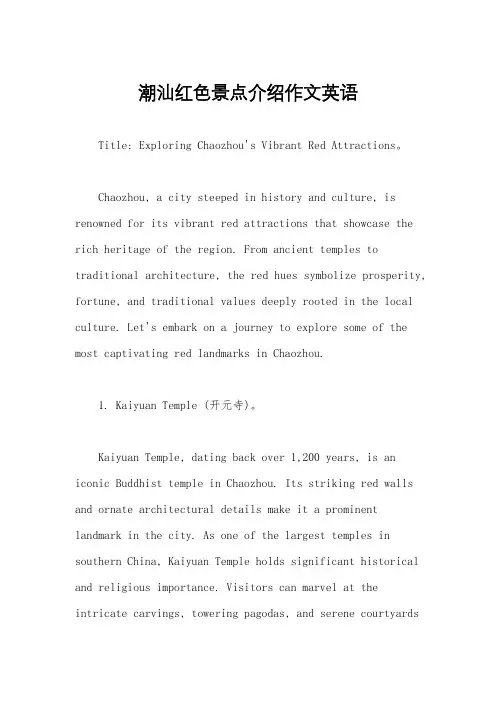
潮汕红色景点介绍作文英语Title: Exploring Chaozhou's Vibrant Red Attractions。
Chaozhou, a city steeped in history and culture, is renowned for its vibrant red attractions that showcase the rich heritage of the region. From ancient temples to traditional architecture, the red hues symbolize prosperity, fortune, and traditional values deeply rooted in the local culture. Let's embark on a journey to explore some of the most captivating red landmarks in Chaozhou.1. Kaiyuan Temple (开元寺)。
Kaiyuan Temple, dating back over 1,200 years, is an iconic Buddhist temple in Chaozhou. Its striking red walls and ornate architectural details make it a prominent landmark in the city. As one of the largest temples in southern China, Kaiyuan Temple holds significant historical and religious importance. Visitors can marvel at theintricate carvings, towering pagodas, and serene courtyardsadorned with vibrant red accents. The temple's vibrant red facade stands as a testament to Chaozhou's enduringspiritual heritage.2. Guangji Bridge (广济桥)。
潮汕传统文化英语作文10句话The Chaoshan region, nestled in the southeastern part of Guangdong Province, is a treasure trove of traditional culture, where history whispers through the alleys and theair is seasoned with the aroma of ancient customs.In Chaoshan, the tea ceremony is not just a ritual but an art form, where the delicate dance of pouring and sipping is as graceful as a ballet performance.The Chaoshan opera, with its vibrant costumes and melodious tunes, is a symphony of emotions that can make even the most stoic of audiences tap their feet in rhythm.The Chaoshan cuisine is a culinary adventure, where every dish tells a story, and the flavors are as rich and diverse as the landscapes that inspired them.From the intricate carvings on Chaoshan wood to the delicate embroidery on silk, the region is a canvas of creativity and craftsmanship.The Chaoshan lion dance is a spectacle of agility and power, where the lion's every leap and roar is a testament to the region's vibrant spirit.The Chaoshan New Year is a carnival of colors and sounds, where the streets come alive with parades and the air isfilled with the laughter of joyous celebrations.In Chaoshan, the art of paper-cutting is not just a craft but a window into the soul of the people, where eachintricate cut reveals a piece of their heart.The Chaoshan festivals are a kaleidoscope of traditions, where every event is a celebration of the region's rich heritage and a reminder of the past.The Chaoshan people are known for their hospitality, where every visitor is treated like family and every meal is an opportunity to share stories and laughter.In Chaoshan, tradition is not just preserved but celebrated, where every generation adds their own flavor to the mix, creating a cultural stew that is as flavorful as it is fascinating.。
潮州西湖公园英语作文Chaozhou West Lake ParkChaozhou West Lake Park, nestled in the outskirts of Chaozhou City, is a beautiful and serene oasis that offers a glimpse into the rich cultural and natural heritage of southern China. This celebrated park, renowned as one of the thirty-six West Lakes nationwide, combines the tranquility of nature with the charm of ancient architecture, making it a must-visit destination for both locals and tourists alike.Located in the middle section of Huancheng West Road, Xiangqiao District, Chaozhou West Lake Park is easily accessible and open to the public from dawn to dusk every day, offering a free entry that welcomes all. This accessibility ensures that visitors can immerse themselves in the park's beauty and tranquility at their own pace.One of the park's most captivating features is its expansive lake, which serves as the heart of the park. The lake's crystal-clear waters reflect the lush greenery surrounding it, creating a serene and picturesque landscape. Visitors can indulge in a variety of water activities such as fishing or boating, adding a touch of adventure to their visit. Additionally, the park boasts a diverse array of trees, flowers, and animals, providing a haven for nature lovers to explore and appreciate the beauty of the natural world.Chaozhou West Lake Park is not just a natural paradise; it is also a treasure trove of historical sites. The park houses several landmarks that tell the story of Chaozhou's past, including Xilu Temple, Zhaozhou Bridge, and Hanbi Tower. These ancient structures, with their intricate designs and historical significance, offer visitors a glimpse into the city's rich cultural heritage.Moreover, the park is dotted with numerous other historical relics, such as the Chen Boer statue, which commemorates a renowned artist, and the Moya Inscriptions, a collection of ancient carvings that showcase the park's deep historical roots. These attractions serve as living testaments to the city's past, adding a sense of depth and meaning to the park's landscape.In addition to its natural and historical attractions, Chaozhou West Lake Park also offers a wide range of recreational activities for visitors to enjoy. From leisurely strolls along paved trails to lively picnics in designated areas, the park caters to all types of visitors. The park's playground and zoo provide entertainment for children, while the museum and occasional concerts or other events add a touch of culture and excitement to the mix.Chaozhou West Lake Park is a unique blend of natural beauty, historical significance, and recreational opportunities. Its tranquil lake, lush greenery, and ancient structures combine to create an unforgettable experience for all who visit. Whether you are a nature lover, a history buff, or simply looking for a peaceful escape from the hustle and bustle of city life, Chaozhou West Lake Park has something to offer you. With its free entry and easy accessibility, this park is a true gem that should not be missed.潮州西湖公园潮州西湖公园,坐落于潮州市郊,是一个美丽而宁静的绿洲,展现了中国南方丰富的文化和自然遗产。
Exploring the Charms of Chaoshan: AJunior High PerspectiveNestled in the southeast corner of China, Chaoshan, a region encompassing the cities of Chaozhou, Shantou, Jieyang, and Fengkai, is a cultural and historical treasure trove. This region, often referred to as the "home of overseas Chinese," boasts a rich tapestry of traditions, customs, and delicious cuisine that have withstood the test of time. As a junior high student, exploring theintricacies of Chaoshan culture has been an eye-opening and delicious adventure.The landscape of Chaoshan is as diverse as its culture. Rolling hills, lush rice paddies, and bustling marketplaces provide a scenic backdrop for the region's vibrant life. One of the most striking features of Chaoshan is its intricate network of canals, known as "kai." These waterways, once used for transportation and trade, nowoffer a serene and scenic way to navigate the region.But what really sets Chaoshan apart is its cuisine. The region is famous for its delicious dim sum, including the famous "chao zi," or steamed pork buns. These buns, withtheir soft and fluffy exterior and succulent filling, are a testament to the region's culinary prowess. Other must-try dishes include the savory "fish porridge" and the sweet "red bean paste buns," both of which offer a unique flavor experience.Beyond its cuisine, Chaoshan is also renowned for its rich cultural heritage. The region is home to numerous temples and shrines dedicated to various deities, many of which are over a hundred years old. These temples are not just places of worship; they are also repositories of historical and cultural knowledge, offering a window into the region's past.The people of Chaoshan are as enchanting as their culture. They are known for their hardworking spirit, entrepreneurship, and deep-rooted sense of community. The region's overseas Chinese population, in particular, has made significant contributions to the global economy, carrying the torch of Chaoshan culture wherever they go.In conclusion, Chaoshan is a region that deserves to be explored and appreciated. Its rich cultural heritage, delicious cuisine, and enchanting people offer a unique andrewarding experience for junior high students. From its scenic landscapes to its vibrant marketplaces, Chaoshan is a cultural gem that continues to shine brightly.**探寻潮汕魅力:初中生的视角**位于中国东南角的潮汕地区,包括潮州、汕头、揭阳和丰顺等城市,是一个文化和历史的宝库。
潮汕婚俗英文作文In Chaoshan, wedding customs are full of traditional rituals and practices that have been passed down for generations. From the elaborate engagement ceremony to the lively wedding banquet, every step of the process is carefully planned and executed to ensure a successful union between the bride and groom.During the engagement ceremony, the groom's family presents gifts to the bride's family as a symbol of respect and gratitude. This gesture signifies the willingness of both families to unite and support the couple in their future together. The exchange of gifts is a crucial part of the engagement ceremony, as it symbolizes the merging of two families into one.One of the most important rituals in a Chaoshan wedding is the tea ceremony, where the newlyweds serve tea to their parents and elders as a sign of respect and gratitude. This tradition is deeply rooted in Chinese culture and is a wayfor the couple to show their appreciation for the love and support they have received throughout their lives. The tea ceremony is a heartfelt moment that symbolizes the couple's commitment to honoring their families and traditions.Another unique aspect of Chaoshan weddings is the use of traditional attire, such as the qipao for the bride and the changshan for the groom. These traditional garments are rich in symbolism and are worn to honor the cultural heritage of the couple. The intricate designs and vibrant colors of the clothing add a touch of elegance and sophistication to the wedding ceremony, making it a truly memorable occasion.In addition to the traditional rituals and practices, Chaoshan weddings are also known for their festive atmosphere and delicious cuisine. The wedding banquet is a lavish affair that features an array of mouthwatering dishes, including seafood, meats, and vegetables. Guests are treated to a sumptuous feast that reflects the abundance and prosperity of the newlyweds' union.Overall, Chaoshan weddings are a beautiful blend of tradition, culture, and celebration. From the heartfelt rituals to the delicious food, every aspect of the ceremony is designed to honor the past, celebrate the present, and look forward to a bright future for the newlyweds.。
潮汕出花园的典故《潮汕出花园的典故篇一》嘿,大家好呀!今天我来给你们讲讲潮汕出花园的典故。
在潮汕地区呀,每个孩子到了 15 岁那年,都有一个特别重要的仪式,那就是出花园。
我记得我邻居家的小哥哥那年就经历了这个特别的时刻。
那时候,小哥哥的爸爸妈妈可重视啦,提前好长时间就开始准备。
家里到处都洋溢着喜庆的氛围。
小哥哥呢,一开始还不太明白这个出花园到底是咋回事,就天天缠着爸爸妈妈问。
他妈妈笑着说:“傻孩子,出花园呀,就意味着你长大了,要更懂事啦。
”小哥哥似懂非懂地点点头。
到了出花园那天,小哥哥穿上了新衣服,那身衣服可帅气啦,红色的,特别显眼。
家里还摆了好多好吃的,有红鸡蛋、卤鸭、水果什么的。
亲戚朋友们都来了,大家都笑着跟小哥哥打招呼。
小哥哥的爷爷奶奶坐在沙发上,看着小哥哥,眼里满是慈爱。
爷爷说:“孩子呀,以后可不能再像个小孩子一样调皮咯。
”小哥哥调皮地吐吐舌头说:“知道啦,爷爷。
”这一天,小哥哥还收到了好多红包呢,把他高兴坏了。
他拿着红包在小伙伴面前炫耀,小伙伴们都羡慕得不行。
晚上,一家人围坐在一起吃饭,小哥哥的爸爸妈妈不停地给小哥哥夹菜,嘴里还说着:“多吃点,以后要健健康康的。
”小哥哥吃得肚子圆滚滚的。
这就是潮汕的出花园呀,一个充满欢乐和祝福的仪式,见证着孩子们的成长。
我想,等我到了 15 岁,也一定会有一个难忘的出花园仪式的!《潮汕出花园的典故篇二》哎呀呀,今天接着给你们讲讲潮汕出花园的另一个故事。
我记得有一次去参加一个远方亲戚家孩子的出花园仪式,那场面可热闹了。
我们一到他们家,就看到门口贴着大红的对联,特别喜庆。
亲戚们都在忙碌着,有的在摆放食物,有的在招呼客人。
那个要出花园的小姐姐穿着一身漂亮的粉色裙子,头上还戴着一朵花,特别好看。
她有点害羞地站在那里,看着大家。
我跑过去跟她打招呼:“姐姐,恭喜你出花园呀!”她笑着说:“谢谢你呀。
”仪式开始了,小姐姐先去洗了个澡,换上了新鞋子。
然后她的爸爸妈妈带着她来到祖宗牌位前,让她上香拜祭。
At that day, the chil d’s mum should gathers 4, 8 or 12 kinds of things, which are including 3 kinds of meats and many kinds of fruits. After putting them on a shallow basket, the child worships(祭拜)the censer(香炉) of their In-laws god(公婆神),and after that, they d on’t need to do it any longer.
The chil d who goes out of the garden should have to wear new clothes and red wooden shoes(红皮屐).As for boys, they have to eat the head of a rooster ,while girls have to eat the head of a hen or a duck. Because peopl e here thought chil dren wear such clothes and eat those food can bring lucky to them. In some areas , such as Chenhai(澄海), Chaoan(潮阳)and Raoping(饶平), according to their customs , parents ask their child to take a show with 12 types of fresh flowers. However , chil dren have to eat the intestine and the stomach of a pig in Jiedong(揭东), Puning(普宁)and Huilai(惠来),and they call it ‘the replacement of intestines and stomach'.
At that noon, in some families, especially whose elder child or their son are to go out of the garden, they will invite many guests to have a big lunch. Because the protagonist(主角)can’t meet with strangers, almost the gusts are their relatives and friends. During the lunch, everyone else has to obey the rules of the seats, the protagonist(主角)have to sit at the main seat,
even thought their grandparents are at present. In ad dition, the head
of the chicken have to face to him or her, and others can’t eat the chicken. This means him or her will become outstanding and prosperous(兴旺发达)when he or she grows up.
The food of the lunch is really rich, the masters will supplies meat, three kinds of eggs and so on. Altogether there are 12 dishes. The vegetables mainly are green garlic(青蒜),celery(芹菜)and a kind of local vegetabl e calls ‘Houhe’(厚合).The green garlic means that they hope their chil dren can cal culate well(能除会算)after eating it, and celery means they will study and work hard. By the way, there are many taboos(禁祭)that, for example, children aren't allow to climb ups and downs and cross bridges in Jieyang(揭阳), and they can’t see baggers in Shantou(汕头).
译文:将三牲果品合凑成四件、八件或十二件,陈置在俗称“胶掠”上,请出
公婆神的神炉,由“出花园”的孩子跪拜,拜毕,以后就不再拜了。
“出花园”的孩子要穿新衣,穿红皮屐,男孩要吃公鸡头,女孩要吃母鸡头或鸭头。
潮汕人认为孩子穿红木屐和咬鸡头能带来吉利。
澄海、潮安、饶平等地习俗要用12样鲜花泡水给“出花园”者沐浴,揭东、普宁、惠来等地要让孩子吃猪肠猪肚,俗称“换肠肚”。
当日中午,一些人家,尤其是家里的大孩子或男孩子出“花园”的,会大宴宾客。
因为主角是不能见到陌生人的,所以所谓的大宴宾客,其实也就是亲朋好友。
“出花园”者的座位也是有讲究的,这一天,上座的必定是主角,哪怕入座中有爷爷辈分的长辈也如此,这一天,他(她)用餐坐上正位,鸡头朝着他(她),别人不可动熏由“出花园”者自吃,鸡头便成了“出花园”者的专利,其意是长大后能出人头地,兴旺发达。
中午进餐时,备办丰盛的午餐,有肉、三鸟蛋,共十二道菜。
青菜以厚合、青蒜等为主,其意是吃了厚合,“出花园”后处处“六合”;青蒜,长大后能算会除,聪敏伶俐;芹,是终身勤劳。
“出花园”仪式的禁忌颇多,各地大同小异。
如揭阳一带忌爬上爬下,忌过桥;汕头一带不能出门,不能见到乞丐.。